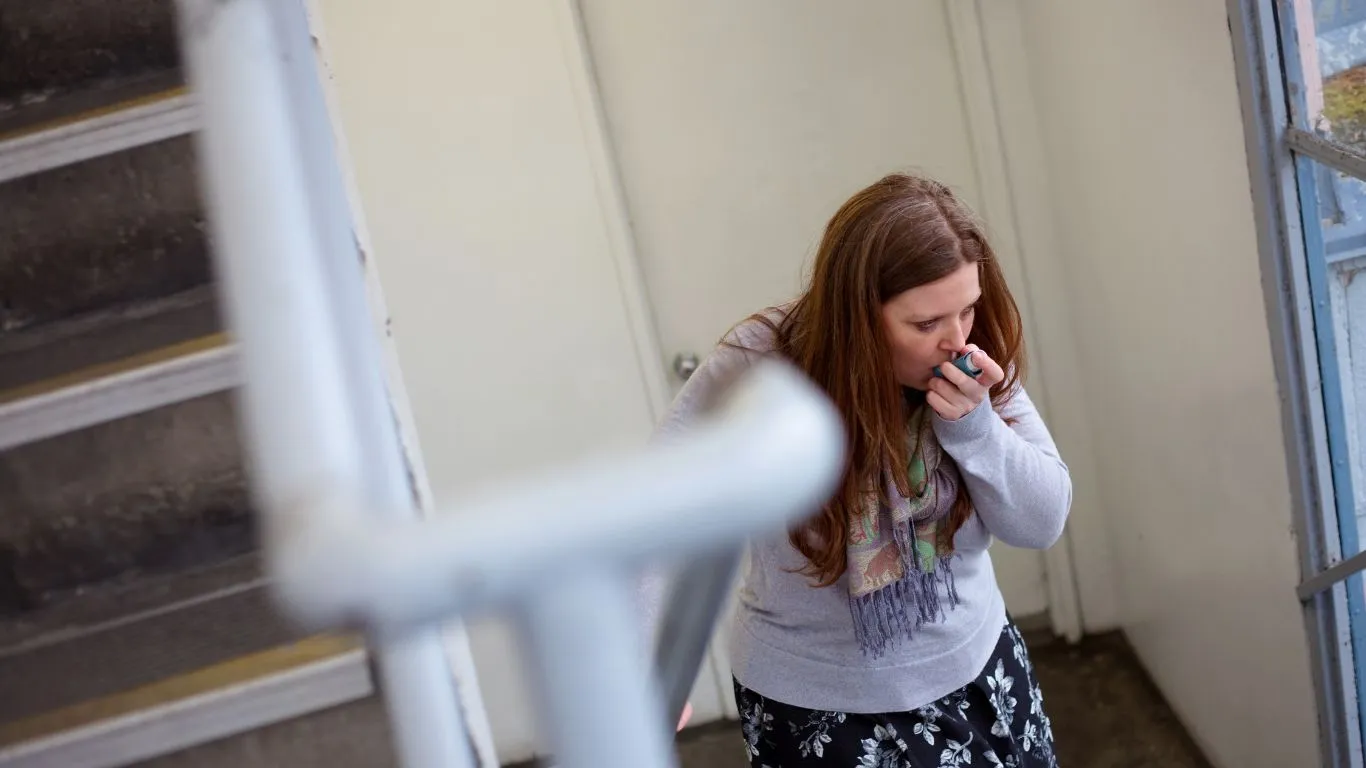Mold Exposure & Asthma: The Hidden Trigger Worsening Your Symptoms!
Can mold exposure cause asthma flare-ups? As someone who has spent years helping people manage their asthma, I can confidently say—yes, it absolutely can. And if you’ve ever found yourself wheezing after cleaning out a damp basement or sneezing uncontrollably in a musty old house, you’re not imagining things. Mold is a sneaky, persistent trigger that can turn a good breathing day into a full-blown asthma nightmare. But why does this happen, and what can you do about it? Let’s dive into the science and practical tips to help you breathe easier.
How Mold Triggers Asthma Flare-Ups

So, what is it about mold that makes it such a nasty trigger for asthma? It all comes down to tiny, airborne particles called mold spores. These microscopic invaders float through the air, waiting for the perfect conditions—moisture and warmth—to settle down and grow. But for those of us with asthma, just inhaling these spores can set off a chain reaction of inflammation and airway constriction.
The Science Behind Mold-Induced Asthma Symptoms
When mold spores enter the lungs, the immune system sometimes mistakes them for harmful invaders. This causes the body to release chemicals like histamine, which can lead to:
- Inflamed airways: Making it harder to breathe.
- Excess mucus production: Leading to congestion and coughing.
- Bronchial spasms: Causing wheezing and shortness of breath.
For people with asthma, this reaction is amplified. I’ve had patients walk into my office feeling totally fine—until they moved into a new apartment with hidden mold problems. Within weeks, they were reaching for their inhalers more than ever before. And in some cases, their once-controlled asthma became severe and unpredictable.
Where Mold Hides in Your Home

You might think mold is only a problem in old, damp houses, but trust me—it can sneak up on you anywhere. Even in a clean home, all it takes is a little unnoticed moisture for mold to start thriving. Here are some of the top hiding spots:
- Bathrooms: That musty smell? It’s probably mold hiding behind tiles, under sinks, or in shower corners.
- Kitchens: Leaky pipes and condensation around windows create the perfect environment.
- Basements: The damp, dark nature of basements makes them mold hotspots.
- Air conditioning units: Mold can grow inside vents, spreading spores throughout your home.
One of my patients had a seemingly spotless home but was experiencing sudden asthma attacks. After some detective work, we found the culprit—mold growing inside the HVAC system! A professional cleaning made a world of difference in her symptoms.
Why Some People Are More Sensitive to Mold

Not everyone exposed to mold will have an asthma attack, so what makes some people more vulnerable? It turns out, genetics, immune system sensitivity, and pre-existing respiratory conditions all play a role.
High-Risk Groups for Mold-Triggered Asthma
While anyone with asthma should be cautious around mold, certain groups are at an even higher risk:
- Children: Their developing lungs make them extra sensitive to airborne allergens.
- Elderly individuals: Weaker immune systems can make it harder to fight off mold-related inflammation.
- People with chronic lung conditions: COPD, bronchitis, and other lung issues can worsen with mold exposure.
If you fall into one of these categories, minimizing mold exposure is even more critical.
Signs That Mold Might Be Affecting Your Asthma

Not sure if mold is messing with your asthma? Here’s a hint—if your symptoms seem worse at home, especially in certain rooms, it might be time to investigate. I’ve had patients tell me they felt perfectly fine while on vacation, only to return home and find themselves reaching for their inhalers again. That’s a classic red flag.
Common Symptoms of Mold-Triggered Asthma
When mold spores irritate your airways, you might experience:
- Increased wheezing and breathlessness—especially in damp or musty areas.
- Persistent coughing that gets worse at night or early morning.
- Chest tightness that doesn’t seem to ease, even with medication.
- Frequent sinus issues—think sneezing, congestion, or a runny nose.
- Unexplained fatigue—because your body is constantly fighting inflammation.
These symptoms can overlap with allergies, which makes mold a tricky culprit to pinpoint. A good test? Pay attention to how you feel in different environments. If you suddenly breathe easier after leaving your home or office, mold could be the problem.
How to Test for Mold in Your Home

Suspect mold but can’t see it? That’s because mold often hides in places you wouldn’t think to look—inside walls, under carpets, or even in your air ducts. Here’s how you can track it down:
DIY Mold Detection Tips
Before calling in the pros, try these simple methods:
- Use your nose: A musty, damp smell is a dead giveaway.
- Look for discoloration: Mold can appear black, green, white, or even orange.
- Check for water damage: Peeling paint, bubbling wallpaper, or warped wood are warning signs.
- Use a moisture meter: High humidity levels (above 60%) can encourage mold growth.
For a more thorough approach, mold test kits can detect airborne spores, but they don’t always pinpoint the exact location. If your asthma is acting up and you can’t find the source, it may be time for a professional inspection.
How to Reduce Mold Exposure and Protect Your Lungs

The good news? You don’t have to live in fear of mold-triggered asthma attacks. With the right strategies, you can breathe easier and keep your home a safe space.
Preventing Mold Growth
Since mold thrives on moisture, the key to stopping it is controlling humidity. Here’s how:
- Keep humidity levels below 50%: A dehumidifier can help, especially in damp areas.
- Fix leaks immediately: Even a small drip under the sink can lead to mold growth.
- Ventilate properly: Use exhaust fans in bathrooms and kitchens to reduce moisture buildup.
- Use mold-resistant products: If you’re renovating, consider mold-resistant drywall or paint.
- Clean regularly: Pay special attention to bathrooms, kitchens, and basements.
What to Do If You Already Have Mold
If you’ve spotted mold, don’t panic—but don’t ignore it either. For small areas (under 10 square feet), you can try cleaning it yourself:
- Wear a mask and gloves: Protect yourself from inhaling spores.
- Use a mix of vinegar and baking soda: Bleach works too, but it doesn’t always kill mold at the root.
- Scrub thoroughly and dry completely: Moisture left behind will just invite the mold back.
For larger infestations or if mold keeps coming back, it’s best to call a professional. I’ve had patients who tried DIY removal but ended up making things worse because they didn’t address the moisture source.
Case Studies & Real-Life Examples

Sometimes, the best way to understand the impact of mold on asthma is through real-life experiences. Over the years, I’ve had countless patients who struggled with mold exposure without realizing it was the root cause of their worsening symptoms.
Case Study #1: The Hidden Mold in a “Clean” Home
A few years ago, a patient of mine—let’s call her Sarah—came to me in frustration. Her asthma had been under control for years, but suddenly, she found herself using her inhaler daily. She swore her home was spotless, with no visible mold in sight.
After some digging, we discovered that her attic had a small but persistent leak. The insulation had been absorbing moisture for months, creating the perfect breeding ground for mold. Every time her HVAC system kicked in, it spread mold spores throughout the house. Once she had the insulation replaced and the leak repaired, her asthma symptoms dramatically improved.
Case Study #2: The School That Made a Child Sick
Another heartbreaking case involved a young boy, Michael, whose parents were at their wit’s end. He was fine during summer break but suffered from severe asthma flare-ups once school started. It turned out that his classroom had an old, leaky ceiling with mold growing inside the walls.
His parents fought hard to have the school investigate, and sure enough, mold was discovered. After remediation, Michael’s asthma became much easier to manage. This case was a wake-up call about how important indoor air quality is—not just at home but in schools and workplaces, too.
Key Takeaways: What You Need to Remember

Let’s quickly recap the most important things we’ve covered:
- Mold exposure can absolutely trigger asthma flare-ups. It’s not just about allergies—mold spores can directly irritate the lungs and make asthma worse.
- Mold hides in unexpected places. Even if your home looks clean, mold could be lurking in air vents, behind walls, or under carpets.
- Pay attention to your asthma patterns. If your symptoms improve when you’re away from home (or get worse in specific places), mold might be the culprit.
- Prevention is key. Keeping humidity low, fixing leaks, and ventilating properly can stop mold from taking over your space.
- Professional help is sometimes necessary. If you can’t find the source of mold but your asthma is getting worse, it might be time to bring in an expert.
FAQs
Got more questions? Here are some of the most common ones I hear from my patients.
Can mold cause asthma in people who don’t already have it?
Yes! Long-term exposure to mold has been linked to the development of asthma, especially in young children and those with a genetic predisposition. If you or a loved one doesn’t have asthma but experiences chronic coughing or breathing issues around mold, it’s time to take action.
How can I tell if my workplace has a mold problem?
If you feel fine at home but develop asthma symptoms at work, there could be mold in the building. Signs include musty smells, water stains on ceilings or walls, and worsening respiratory symptoms. Reporting your concerns to building management can help initiate an inspection.
What’s the fastest way to get rid of mold?
Small patches (under 10 square feet) can often be cleaned with vinegar, hydrogen peroxide, or a mold-specific cleaner. However, the key is eliminating the moisture source. Without fixing the underlying issue, the mold will come back.
Bonus: Additional Resources & DIY Tips
Looking for more ways to keep your home mold-free? Check out these expert resources:
- EPA Guide to Mold and Indoor Air Quality
- CDC’s Official Mold Prevention Tips
- Asthma UK’s Guide to Asthma Triggers
Quick DIY Mold Prevention Tips
Try these simple steps to reduce mold in your home:
- Use a dehumidifier. Keeping humidity below 50% makes it harder for mold to grow.
- Keep air moving. Open windows, use fans, and ensure good ventilation.
- Fix leaks fast. Even a slow drip under the sink can lead to mold growth.
- Check your AC filters. Mold can thrive in dirty filters, so change them regularly.
- Use mold-resistant paint. If you’re repainting, opt for mold-resistant formulas.
Appendix: References, Disclaimer & Call to Action
References
- Environmental Protection Agency (EPA)
- Centers for Disease Control and Prevention (CDC)
- World Health Organization (WHO)
Disclaimer
This article is for informational purposes only and should not be taken as medical advice. If you have asthma and suspect mold exposure is affecting your health, consult a healthcare professional.
Call to Action
Mold and asthma don’t mix—but you don’t have to suffer! If you found this article helpful, share it with friends and family. Have a mold-related asthma story? Drop it in the comments—I’d love to hear how you handled it!

Bianca Nala is a compassionate Nurse Practitioner with a strong background in primary and respiratory care. As a health writer for Healthusias.com, she combines her clinical expertise with a talent for clear, relatable storytelling to help readers better understand their health. Bianca focuses on topics like asthma, COPD, chronic cough, and overall lung health, aiming to simplify complex medical topics without losing accuracy. Whether she’s treating patients or writing articles, Bianca is driven by a single goal: making quality healthcare knowledge accessible to everyone.





